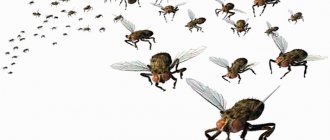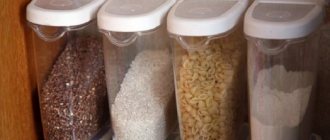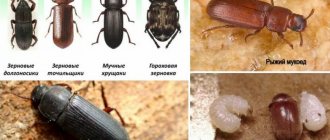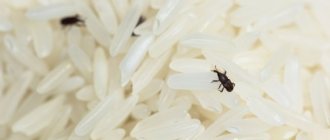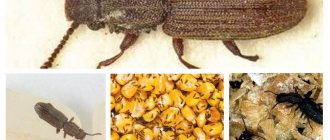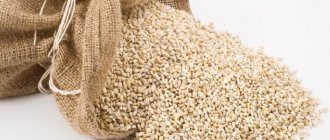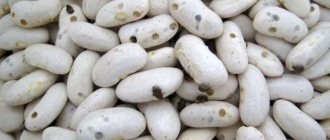Insects are everywhere around humans - they pollinate plants, destroy harmful arthropods in the area, are themselves dangerous pests of agricultural crops, carry diseases, damage furniture and fabrics, are even used in some places for food or are raw materials for the production of dyes and poisons...
We have already told you in detail about beneficial and harmful beetles in the garden, today we will talk about apartment “guests” from the order Coleoptera, which for the most part are not the most pleasant neighbors for humans.
If there are bugs in the kitchen, expect trouble. Obviously, insects have settled in your neighborhood not to brighten up your loneliness, keep you company, or decorate your interior. Your food supplies are their main goal, available food in huge quantities.
Most often, insects settle in cereals and flour - substances especially rich in carbohydrates. Food moths love to feast there, which we have already told you about in detail. Today we’ll talk about harmful representatives of the order Coleoptera (Beetles).
Do bugs in cereals pose a danger to human health and what effective methods exist to combat uninvited insects in the kitchen? Let's figure it out together.
What insects can live in cereals and flour?
What to do if there are bugs in cereals or flour?
To know how to get rid of bugs in cereals and flour, you need to know who exactly you need to fight. Most often, flour beetles and food moths are found in cereals and flour.
The Surinam mucoedis is an insect of the order Coleoptera, a brown pest. It lives in granaries, mills, shops, houses and apartments.
In its development, the mucoed goes through several stages: egg, larva, pupa, and adult. The larva is very small in size - no more than 0.9 mm, so it is very difficult to detect. The mukoed lives from 0.5 to 3 years, laying up to 600 eggs.
Under favorable conditions (air temperature 25-27 degrees and humidity about 65%), the insect reproduces 2-3 times faster than at lower temperatures and humidity.
The Indian food moth is a small butterfly, up to 1 cm long. It lives only 2-3 weeks, but during this time it manages to lay up to 400 eggs, which then become caterpillars. The latter spoil the food by eating everything that is nearby.
After a few weeks, the grown larvae become pupae, and these, in turn, become adult butterflies, ready to produce new offspring.
Both flour eaters and moths are very tenacious, even in frost they do not die immediately. This must be taken into account in order to understand how to get rid of bugs in flour and cereals.
The photo below shows another type of bug that can be found in cereals or flour in your kitchen - this is the flour beetle:
Is it possible to eat cereals or flour if there are bugs in it?
One of the most common questions that arises among people who encounter insects in the kitchen: if there are bugs in the cereal, can it be eaten? Seeing that there are insects in cereals or flour, it is unlikely that anyone will want to eat them. But if we ignore the psychological component, is it possible to sort out the cereal, wash it and be sure that there are no bugs?
The answer to this question is negative. The fact is that even if you sort through the cereal and remove all the bugs, the larvae may simply not be noticed. They are small and have an inconspicuous color.
In addition, the cereal contains waste products of bugs, caterpillars and larvae: feces, dead larvae, husks that remain during degeneration into a pupa or butterfly.
The situation is somewhat different with flour. It can be sifted into a fine sieve, through which neither larvae nor debris left by bugs will pass. This is one way to get rid of bugs in flour.
After this operation, it is recommended to heat the sifted flour in the oven at 50 degrees.
Prevention
After the contaminated product has been removed, you must first review all other cereals and wash cabinets, jars or other containers used for storage with laundry soap and soda.
All cereals that are in the same room with infected pests should be placed under the scorching sun for several hours, and then placed in the freezer for 48 hours.
But the work doesn't end there. It is necessary to boil water and treat all the cracks in the floor, doors, joints and connectors on the windows.
This work is carried out after detection of uninvited guests in the cereal. And to prevent their occurrence you just need to follow these recommendations:
- all cereals, even if they were purchased in sealed packaging, must be baked in the oven for at least a quarter of an hour;
- You should not buy a lot of products at once, this will significantly reduce the risk of infection;
- In each jar of cereal you can put a cut clove of garlic or a large bay leaf;
- nuts and dried fruits should be kept separately;
- shelves and cabinets must not only be kept clean, but also regularly wiped with a vinegar solution.
Interesting: At what temperature can a refrigerator be operated?
Read also: The child drank Miramistin
Knowing where bugs come from in rice and other cereals, how to avoid it and how to deal with the scourge, you can save not only money on food, but also your nerves. We are sure that our recommendations will be useful to you.
Also, find out how to get rid of ants in the kitchen.
If the bugs have just begun to attack your supplies, you can sift the cereal several times through a fine sieve, and then bake it for half an hour in an oven preheated to 100-110 degrees. Before cooking, it doesn’t hurt to rinse the grains several times and soak them in salt water.
How to quickly get rid of insects in the kitchen
Do not forget that some pests are prone to rapid reproduction. If you notice bugs in your food, clean it immediately and check the entire room step by step.
All methods of getting rid of bugs can be divided into 3 groups:
- mechanical;
- chemical;
- use of folk recipes.
Mechanical methods
- It is necessary to find all places where kitchen animals accumulate. Check all food and furniture and do a deep cleaning. Unopened packages must be opened and inspected carefully.
- Process all bulk products. To do this, pour everything one by one onto a baking sheet and heat in the oven. In cold weather, take all food out to the balcony for 5 days.
- Do some general cleaning. Clean and wash everything. Treat wooden surfaces with vinegar solution. If you used a vacuum cleaner, do not forget to process the garbage bag. It should be washed and frozen for 5 days. Insects are not afraid of household cleaning products. It is optimal to use boric acid.
- Dishes in which affected food was stored should be thrown away or washed and frozen.
- In the future, store all bulk products in airtight jars.
- Don't forget to seal any holes you find.
If few insects are found, then some products are worth trying to save. To do this, the cereals must be heated in the oven at a temperature of 100-150 degrees for 10-15 minutes or, conversely, frozen for 2-3 days.
Chemicals
Chemicals in the kitchen are a last resort. First, try to solve the problem using traditional methods. The most harmless chemical is pyrethrum. They need to be sprinkled where food is located. The powder is harmless to people and pets.
It is best to clean the kitchen with products containing chlorine. For best results, wipe all surfaces several times.
Antizhuk furniture impregnation is sold in specialized stores. She should treat all wooden furniture according to the instructions for use. Do not treat surfaces in direct contact with food.
Folk remedies
To combat kitchen insects, the following may be useful: vinegar, garlic, wormwood, nutmeg. The stronger the smell, the better.
You can prepare traps for beetles. On the shelves you need to lay out adhesive plaster sprinkled with garlic and other fragrant spices. You need to wipe the storage areas of cereals and other products with vinegar.
Another effective way to get rid of pests is the use of boric acid. The effectiveness of this method is that the bug does not die immediately, but manages to bring the poison to the place where its relatives gather. To prepare the trap:
- Place sheets of paper or cardboard around the kitchen.
- Mix boric acid with powdered sugar or honey.
- Place the resulting composition on sheets and leave for a couple of days.
How to deal with weevils
Weevils are carriers of fungal infections. In addition, the contaminants left by the beetles in the grain cause allergic reactions. Substances from the larvae provoke the growth of tumors and the cessation of tissue repair.
Therefore, if contaminated grain enters the house, measures are taken immediately. Folk remedies, chemicals or mechanical methods will help.
Mechanical control measures
To detect pests in time, you should inspect your kitchen more often. Infected products are thrown away, and suspicious ones are processed in an oven at 50 degrees or placed in the freezer for 1 hour.
Remove dust from cabinets and shelves. Purchased cereals are sorted and stored in containers, not in bags.
Chemical remedies against rice bugs
Plants are treated with chemicals until the harvest or storage areas are harvested. Should not be used indoors.
Wet treatment with insecticides is recommended:
- Kinmiks,
- Karbafos-500,
- Fufanon,
- Decis or Fitoverm.
Folk remedies include a soap solution for washing containers and storage areas, and treatment with a vinegar solution.
The smell of garlic or orange peels, lavender or clove seeds, mint or bay leaves placed next to the supplies will repel rice bugs. Dry red pepper is poured into jars of peas, and a piece of metal wire can be usefully placed in a bag of cereal.
How to store cereals to prevent bugs?
Methods for storing cereals, as well as preventive measures, are quite simple:
- Clean closets and utility rooms regularly.
- Store bulk products only in clean, hermetically sealed containers.
- Do not store large quantities of cereals in one place.
- Conduct weekly control checks for infestation.
- Place purchased cereals and flour in the freezer for disinfection overnight.
- Store long-lasting foods (legumes, nuts, dried fruits) in the refrigerator.
- The room with stored cereals should be well ventilated and have a low level of humidity.
- For prevention, place a clove of garlic or orange zest in a container with cereal.
- Keep it clean, don't litter.
A bug in the kitchen is not the end of the world. Using the tips given above, you can easily cope with the problem that has arisen and even prevent it.
Chemicals in pest control
If there are bugs in the cereal, what should you do when the previous methods above do not give the desired effect? In such cases, it makes sense to use chemicals. The active drugs are Karbafos and Antizhuk. The second has a universal effect, helping to cope not only with kitchen bugs, but also with wood bugs that damage furniture, windows, laminate and parquet. The drug must be used with extreme caution, following the instructions.
Another remedy against pests, Rogneda, is a powerful antiseptic that allows you to dispose of a number of domestic insects, including mucous beetles, weevils, cockroaches and ants.
You can also remove bugs from the kitchen using the drug “Lovin Fire Protection”, which allows you to achieve a quick effect. The product has a high level of toxicity and is used when there are no animals or children at home.
Where can I find
Insects live in various foods and love flour and pasta.
Crackers
Bread grinders, which are light brown in color, live in bakeries. Such bugs fly well, hide under the windows in the apartment and gobble up crackers.
Cookie
Tiny insects love straws and are found in drying biscuits. In both a small store and a supermarket you can buy gingerbreads and baked goods, cookies with worms. Such guests appear during long-term storage in the kitchen.
Nuts
Under favorable conditions, food moths begin to multiply. It is not poisonous, but spreads quickly, lays eggs, from which larvae crawl out and adore walnut kernels.
Dried fruits
Compotes rich in vitamins are made from prunes, dried apricots, and apricots. But if the harvesting technology is violated or the storage rules are not followed, dried fruits are attacked by microscopic moth caterpillars.
Food Ingredients
The products contain carbohydrates, fats, proteins, which are necessary for the normal functioning of the body. Insects look for food in different food components.
Bread
Not all mini-bakeries follow the technology for baking loaves and other products. And if the norms are violated, bugs crawl from contaminated flour into damp bread.
Beans
In legumes, weevils appear not only due to improper storage; the parasites attack the plants even in the garden before harvesting. If at least one bug is detected in the beans, they are sent to the freezer or hot oven.
Tea coffee
You can bring grinders from the store into closed cabinets where spices and grains are stored, but moths love not only dried fruits. Insects are not averse to eating tea, cocoa, and coffee beans.
Flour
Bugs that get into the kitchen begin to feed on bulk products and spices. At mills, flour is obtained from wheat, rye, and corn, which is packaged in bags and packages and delivered to stores or warehouses. You can buy such a product already with bugs.
Vegetables
In recent years, a lot of pests have appeared in the fields. To cope with insects, crops have to be sprayed. But if cucumbers, cabbage or tomatoes are stored in improper conditions, they begin to rot and worms and beetles appear.
Furniture
Grinders take up residence in old sofas, chairs, and wooden floors. Insect larvae feed on wood, making passages in it.
Appliances
Cockroaches take up residence in a microwave oven, an electric meat grinder, a gas stove, and even in a refrigerator, and they are not easy to get rid of.
Insects grow and reproduce quickly, but you need to fight them in your apartment carefully so as not to harm your household
Hard to reach places
Even clean housewives have bugs in the kitchen, which are difficult to remove because they hide in cracks, in ventilation, and crawl under the bathtub. The springtail insect eats the roots of flowers, climbing deep into a pot of soil.
How to get rid of re-infestation of bugs in the kitchen
To prevent re-infestation by pests, the following precautions must be taken:
- Store flour, cereals, cookies, spices, dried fruits, nuts and pet food in clean, dry, tightly sealed metal or glass jars or heavy plastic containers. This storage method will prevent bugs from getting into the container and spreading around.
- Another proven storage method is to put the cereal in the freezer or refrigerator.
- Some housewives recommend placing the following in containers with food and on cabinet shelves: several cloves of peeled garlic, without cutting off the top; bay leaves, nutmeg or clove inflorescences; a couple of pads or strips of mint chewing gum; steel nail or wire, after wiping it with a dry cloth, since when washing, moisture can lead to corrosion of the metal and spoil the food.
- Buy food products in such quantities that they can be consumed within 2-3 months.
- First of all, use cereals from already opened or damaged packages.
- When buying cereals, flour or flour products packaged in a factory, you need to check the expiration date, the integrity of the packaging and inspect for the presence of insects in the pack.
- It should be remembered that soft packaging does not protect against pests.
- Food storage areas should be kept clean and dry, because accumulated food debris and crumbs are an excellent breeding ground for bugs and midges.
- If, after the measures taken, the bugs appear again, then it is worth inspecting the neighboring rooms, identifying breeding sites and repeating preventive actions. If ineffective, you should contact a pest control service.
Knowing the types, signs and causes of occurrence, following tips and recommendations for preventing infestation, you can get rid of these unpleasant little pests forever.
https://youtube.com/watch?v=NzJAWDvm5Zw
How to properly store cereals to prevent bugs?
A common problem with bugs appearing in products is improper storage and expiration dates.
What to do to protect yourself from kitchen pests at home.
To do this, there are useful recommendations on how to properly store cereals to prevent bugs from getting in:
- Deep clean your closets as often as possible.
- Inspect the contents of bulk products and their appearance.
- It is better to store cereals in plastic or iron containers with tightly closed lids.
- Ventilate cabinets where bulk products are stored, open lids on containers.
- The storage area should be dark and cool.
- Along with the food there should be spices, pepper, bay leaves, and garlic. They repel insects with their smell.
- Fabric bags can be washed with laundry soap. Afterwards, they must be rinsed thoroughly in clean water. Also treat containers with soap and saline solution.
- If you buy cereals in packages, you need to touch them with your fingers for the presence of lumps.
Important to remember! If products have expired, you need to get rid of them. They can be a source of infection of other bulk cereals by pests. All housewives should not allow high humidity in the room; it is the optimal condition for the spread and breeding of offspring for insects
All housewives should not allow high humidity in the room; it is the optimal condition for the spread and breeding of offspring for insects.
Useful video
https://youtube.com/watch?v=NzJAWDvm5Zw
Causes of flour bugs
It's easy to get bugs. Both the owner and the manufacturer of the product can provoke their appearance. This may be a violation of GOST technologies or storage conditions and incorrect “neighborhood” in the warehouse, a violation of the tightness of the packaging, the expiration of the cereal, or ingress from the outside.
Through the fault of the housewife, infection can occur at home:
- Improper storage of cereals. Increased dampness in the house and storage in unsealed conditions create conditions for the appearance of insects. Cereals should not be stored in a warm place.
- Storage of expired products. Cereals that have been stored for a long time have a much higher chance of becoming food for pests. You should always check the expiration date and throw away bad cereals promptly.
- Incorrect packaging. When storing in bags, they should be closed, avoiding open areas. Ideal containers are glass or plastic containers with lids.
Treats from relatives and neighbors can also cause infection. Especially if you take from your hands products that are loved by pests. These are not necessarily cereals; sometimes insects can enter the house with other household items.
Some places are favorite among harmful insects. Especially because they are the hardest to find there:
- Food products and their remains in bags, unsealed containers and other containers. Especially tea leaves, seasonings, dried fruits.
- In a kitchen set, they become the sole owners of the shelves and are able to gnaw holes in them.
- Other furniture.
Risk areas include the cooking area, where waste particles are regularly left behind.
Attention! They can get into the house in a thousand ways, from barley borrowed by a neighbor to purchased furniture and equipment.
In some cases, bugs can settle in places that are “inedible” for them. Therefore, when buying products secondhand or borrowing products from someone, it is better to be vigilant. Goods purchased by weight or at fairs are also dangerous.
What kind of bugs are these?
Often, dry cereals are inhabited by small beetles, red flour beetles and bread borers.
Lesser mealworms are small, only 3-3.5 mm in size, reddish-brown beetles with short antennae, rounded sides and small wings (however, they cannot fly).
These insects enter the kitchen from brought bags of starch or flour, from where they spread throughout the entire area, crawling into cracks, latches, and loosely covered containers with dry foods. These creatures especially “respect” flour, rice, buckwheat, semolina, Artek cereals, millet and dried fruits.
Under favorable conditions, flour beetles reproduce well, producing up to four generations per year.
Products damaged by the beetleworm become lumpy and, of course, unsuitable for food. Their use is fraught with allergic reactions, stomach upset, or even poisoning.
Red flour beetles, as a rule, live in industrial enterprises - mills, bakeries, and feed mills. These are small (1.5-2.5 mm long) coleopterous insects of a rusty-yellow color, covered with small silky hairs with long, widely spaced antennae.
The taste preferences of these bugs are quite limited - flour eaters do not damage products whose moisture content is less than 15-17%; they are mainly content with rotting flour or cereals (most often corn) and dry animal feed. By gathering in groups in food, mucous beetles increase their humidity and contaminate them with excrement and shells from larvae.
A characteristic sign of the presence of a flour eater is the flour sieves it has gnawed through.
Bread borers are the most tenacious, prolific, voracious and unpretentious pests. It will take a lot of effort to get them out. These are small beetles (1.8-3.7 mm long), cylindrical in shape from light brown to red-brown in color, covered with short silky hairs.
Often in a home where grinders have infested, you can see living or dead insects on the windowsills. They love to eat dry products of animal and plant origin: various cereals, grains, tea, coffee, flour products, crackers, animal feed, cookies, dried fruits, nuts, dry medicinal plants (even poisonous ones!) and tobacco.
Traces of the presence of grinders can also be found in book bindings and herbariums, where they leave many passages, depositing the products of their vital activity in them.
The special cunning of bread grinders is that with a slight infection, their stay in the food substrate is secretive - they do not show themselves outside. But with a high population density, pests can be found on windows, walls and floors indoors.
Eating products that contain bread borers, especially without heat treatment, is harmful to health!
What is the danger of mucoed?
The flour-eating bug settles in bulk products, making them completely unsuitable for further consumption. It feeds on cereals, flour, dried fruits, leaving behind husks and excrement. Thereby also increasing the moisture content of the products, causing rotting processes in them.
Little pests love warm and dark places, which is usually kitchen cabinets. Suriname mucoeds reproduce very quickly: after laying, dozens of larvae become adults within a month. Such high fertility complicates and delays the process of fighting beetles.
Flour eaters are also dangerous because they not only spoil food, but also infect it. When they enter the human body, they can cause allergies and intestinal disorders.
Therefore, you should always keep all bulk and dry products clean.
An effective method of struggle
Pathogenic microorganisms settle in cereals, dried fruits, and flour damaged by bugs, but not everyone knows whether it is possible to avoid the appearance of insects in food products and how to deal with them.
Inventory inspection
If there are cereals, spices, tea in the kitchen or pantry, or beans, beans, dried apples, plums or pears are stored, the first thing to do is to carefully inspect the bulk products. The presence of insects is indicated by the appearance of husks.
Damage assessment
Having found traces of beetles, you need to check how damaged the cereals or dried fruits are. The flour can be sifted to get rid of the larvae if there are only a few of them. It is better to destroy products that are heavily chewed by insects.
Safe processing methods
To remove bugs and larvae, you must first try a method that does not harm humans.
Freezing
Most insects that live in bulk products die at low temperatures. Having identified traces of pests in a bag of cereal, it is left in the freezer for several days.
Roasting in the oven and sifting through a sieve
If the number of beetles and larvae in semolina, flour, and millet is small, it is worth trying to save the products. Insects cannot tolerate not only low but also high temperatures. The cereal and ground grain are passed through a fine sieve and then put into the oven, heated to 50 °C.
Disposal
Products found that cannot be fried or frozen due to severe damage by insects must be immediately taken to the trash pit along with their containers; the compounds used to treat the cabinets must be poured into the toilet.
Disinfection
To finally remove bugs from the kitchen or pantry, all shelves are cleared of food, crumbs are swept out and disinfected with a solution prepared from a liter of water and 20 ml of vinegar. The cracks in which insects lay eggs are poured with boiling water or removed with a vacuum cleaner.
Making bait from borax
You can attract bugs in order to deal with them later using balls, which are placed in cabinets that have been washed and disinfected in advance. To prepare them you will need only 3 components:
- ground millet;
- powdered sugar;
- borax.
All ingredients are mixed in equal parts. In addition to the balls, pieces of paper with a ground mixture of baker's dry yeast, sugar and borax are laid out on the shelves. Very quickly bugs will appear near them.
How to deal with odor
Products and herbs that have a rich aroma are effective in combating food moths, red flour beetles and other kitchen insects.
Pyrethrum sprigs
The powder of the plant, found in Transcaucasia and the Balkans, has been popularly used for a very long time to kill bedbugs and harmful insects. The medicine is made from pyrethrum. The twigs of the perennial have a pungent odor that food bugs do not like.
Bay leaf
The spice, which is always present in the kitchen, gives a bright aroma to any dish, drives away insects that adore flour and lay eggs in dried fruits. Bay leaves are scattered in the corners of the disinfected shelf; the bugs do not like the smell of the seasoning.
Dried wormwood
The bitter herb, which has healing properties, grows near houses and gardens like a weed. It is harvested and dried to remove worms and improve appetite. Insects are not able to withstand the smell of wormwood, and bugs will definitely not crawl into the place where the leaves lie.
Carnation buds
Cotton pads lubricated with essential oils are placed in the cabinet, disinfected after identifying food moths:
- geraniums;
- fir;
- rosemary.
The aroma emanating from clove buds repels bugs. Insects do not tolerate the smell of basil.
Peeled garlic cloves
Bugs rarely appear in buckwheat, millet, or rice if a bay leaf or cloves separated from a head of garlic are placed in the container or jar where they are stored.
Lavender
The plant, which has a unique aroma and delicate purple flowers, is used as a seasoning, brewed as tea, and added to alcohol tincture. People really like the smell; insects hate it. You can place a bouquet of lavender flowers and leaves or a swab lubricated with essential oil in the closet. The aroma will drive away bugs.
To destroy eggs, larvae, and adult insects, shelves, cabinets, and glass or plastic containers are disinfected if cereals, flour, beans or dried fruits are stored in them. In addition to wiping surfaces with vinegar, you need to treat the container and room with boiling water and steam.
Let's sum it up
The flour beetle (or beetle) is a pest that feeds on flour, cereals and other products. It leaves behind excrement and chitin after molting, which can cause allergies. The insect can also carry an infection.
To get rid of the parasite, contaminated products are sifted, heated or frozen. In extreme cases, insecticide treatment is carried out. For prevention purposes, cracks in the room through which the beetle can enter are sealed. Substances that repel it are also placed there: steel, garlic, lavender, vinegar.
Where do pests most often occur?
If the kitchen is already infected and there are these insects in flour or cereal, you need to detect foci of infection. You will need to review each of the products.
Bulk products
The following subtleties need to be taken into account:
It is important that you will need to examine any product, without exception, that is stored in the kitchen. Each type of such bugs has certain gastronomic tastes.
But if his favorite food is not available in sufficient quantities, the bug can emigrate from other grains to cereals, as well as sugar, sweets, and nuts. For this reason, you should not skip a single product, so as not to waste a lot of time. These parasites become strongly attached to their places of residence, so they do not go far from them. If you see them on the shelf, you must first inspect the products stored nearby. Even if the package is hermetically sealed, it will need to be inspected. These insects easily chew through materials such as cardboard, cellophane and foil. For this reason, without opening the cereal, you should not think that it does not contain parasites. The best option is to pour the cereal into a plate and watch carefully. These bugs also live hidden - for example, the grinder can gnaw holes in grains and live in them, crawling to the surface only to change the grain. Therefore, a superficial inspection is ineffective.
Video
Simple and affordable methods will help you cope with pests in the kitchen. To understand the intricacies of their use, watch the presented videos:
About the author:
Found a mistake? Select the text with the mouse and click:
Do you know that:
The easiest way to remove scale and carbon deposits from the soleplate of the iron is with table salt. Pour a thick layer of salt onto the paper, heat the iron to maximum and run the iron over the salt bed several times, applying light pressure.
Types of bugs
Unfortunately, parasites living in cereals can be of several types. They practically do not differ in the degree of harmfulness, but each of them prefers special living conditions. Kinds:
- Mucoed beetle. It is also called the Surinam mucoed. Has a red or red color. It prefers to live in wet or rotten cereals and is also often found inside packages of flour. In a group, together with other individuals, they contaminate the food, making it more moist. They often get home in rice, semolina or pasta. They can eat crackers, nuts, and cookies. Such flour and rice lovers are considered the most common.
- Flour beetle. Outwardly, it resembles another type of beetle that is not dangerous to food - the shawl. It has a brown or reddish color, likes to settle in food, bread bins, and secluded parts of the kitchen, and often spreads from the kitchen cabinet. Grows up to half a centimeter long. It prefers to live in rice grains, wheat and rye flour, semolina, as well as wheat.
- Grinder. Representatives have an oval head, grow up to 3 mm, and are dark yellow or brown. They can enter homes by chewing their way through the floor, walls or window frames. They live in pasta, cereals, nuts, cookies or dried fruits.
- Food moth. This insect does not belong to the beetles, but also often appears inside cereal packages. Most often it settles in buckwheat, but it is possible to appear in other cereals.
- Barn weevil. Adults are black in color and up to 6 mm long. They cannot fly, but they reproduce extremely quickly. They are distinguished by a long proboscis nose. They fit with any cereal. Females lay eggs inside the grains, where the insects feed and grow. That's why people only see them as adult beetles.
- Caryopsis. The midges of this bug are dangerous only for beans. They prefer high humidity and average air temperature. Females can lay a large number of eggs in a short period of time.
If you encounter transparent bugs, you should also act immediately. As a rule, developing individuals that have just been born and have not had time to grow have no color. Dealing with them will be a little easier.
Folk remedies for bugs
As a rule, they are designed to scare away rather than destroy uninvited guests.
- Containers for bulk products must be treated with water and vinegar.
- Place citrus peels, garlic cloves, spices (again, this will not help against all pests), lavender, pyrethrum (a type of chamomile) directly into the food packages in gauze bags.
- You can poison the beetles with balls of sugar, honey, eggs or dry yeast with boric acid. From time to time such “delicacies” need to be replaced with new ones.
Industrial products
But if the question of how to remove insects has become serious, you will have to use chemistry. Remedies for uninvited guests can also be found in a hardware store.
- Mashenka chalk will help repel creeping pests - they coat cabinets, baseboards, and cracks with it.
- Karbofos - destroys old insects and does not allow new ones in. Available in aerosol, powder or liquid form.
- “Anti-bug” is a remedy for all types of insects. Toxic.
- Fire protection “Lovin” is a very toxic product that gets rid of adult beetles and “young ones”.
Types of insects in bulk products
Several types of harmful insects live in bulk products:
- flour beetle The length of the insect is about 4 mm, the color of the body is orange-red. Favorite habitats: kitchen cabinets, bread bins, paper bags with cereals. The insect eats rye and wheat flour, semolina, rice, millet;
- Mukoed Suriname. Bulk products are an ideal environment for a pest with an exotic name. Tiny (up to 2 mm) bugs actively multiply in granaries: without a magnifying device it is almost impossible to identify the pest. If larvae or adults get into bags of cereals and flour, then pests from contaminated products penetrate into loosely closed containers with dried fruits, cookies, nuts, crackers, and cereals;
- food moth. The pest is larger than the Suriname flour beetle and flour beetle. The lepidopteran insect grows up to 5–7 mm, the color of the body and wings is light gray with a slight brownish or darker tint. Moths settle in millet, semolina, rice, flour, dried fruits, peas, and other types of bulk products. The pest actively reproduces and causes great damage to products;
- grinder. A bug up to 3 mm long harms cereals, pasta, sweet livers, and dried fruits. The bread grinder actively eats cereals, pasta, and sweets; the house variety of beetles feeds on wood. If there are borers in the cabinets, you need to disinfect them as soon as possible so that the pests do not set up nests in other furniture.
How do uninvited guests appear in a living space?
You purchase kitchen pests from the store yourself. Only moths can fly in. All other insects come to their new place of residence in bags of food. If the package of cereals is transparent, then carefully study what you are going to the checkout with. In addition, new guests may appear in your kitchen from neighbors through ventilation, holes and cracks.
What are bugs?
There are various pests. Flour beetles are widespread in private residential areas; grain grinders and red flour beetles usually live in production areas. If there is damage to dried flour products in the kitchen: crackers, cookies, dryers, it can be argued that they are infested with bread grinders.
Bread grinder
Their external characteristics: small size (up to 3 mm), light brown body color, presence of wings.
Bread borers are the most tenacious, prolific, voracious and unpretentious pests.
Such beetles strive for light, for this reason they are often found near windows on windowsills. Favorite food besides dried flour products: tea, coffee, dried medicinal plants, animal feed. Such insects are introduced along with contaminated food, from where they spread throughout the kitchen supplies.
Red mukoed
If we consider the red flour beetle, then it is usually found in production: flour mills, cereal factories, bakeries. Such bugs can appear in flour and cereals that show signs of rotting. To avoid contamination of products, they should be stored at low humidity (not higher than 15%). If these recommendations are violated, insects will immediately attack the cereal. External signs of beetles: small size (up to 2.5 mm), red color of the body.
This pest cannot damage dry grain whose moisture content is below 15%.
Flour beetle
Flour beetles are common in private housing. This is a red-brown insect whose size ranges from 3 to 4 mm. It is usually brought along with the contaminated product, from where it is distributed in the kitchen among clean cereals. Bugs prefer any flour: rice, wheat, rye. In addition, they settle in semolina and oatmeal. If there is no other food or if there is severe infection, rice, buckwheat, and dried fruits may also suffer in the kitchen.
These insects especially “respect”: flour, rice, buckwheat, semolina, Artek cereals, millet and dried fruits.
It doesn't hurt to know where they live. The most common type - the flour beetle - lays eggs in cereals, crevices of cabinets and other furniture in the kitchen.
Do you eat contaminated food?
If there are too many insects, it is a pity to throw away flour, rice, buckwheat and other cereals. This raises the question, is it possible to eat them with bugs? The answer will be negative, since there is a danger of poisoning. In addition, allergic reactions occur in people who eat such food.
Infected flour and cereals completely lose their beneficial properties, as the beetles draw all the nutrients from the grain. Accordingly, the nutritional value of such products is extremely low.
If bugs are infested in large quantities in the cereal, it will not be possible to save it; it is better not to risk it and throw away the product.
What to do with contaminated products?
If there are bugs in flour or cereals, they need to be removed as quickly as possible, since they will colonize all the reserves in a short period of time. In the case when most of the products are contaminated, there is a temptation to process them and eat them. However, you should think about it, because insects secrete special enzymes and waste products that can cause the development of allergic reactions.
With severe infection, poisoning occurs. There is another danger. When insects infect flour, they lay eggs, from which larvae emerge.
Small pests feed on the bulk product, so its nutritional value is significantly reduced. In addition, worms almost always evoke feelings of disgust and disgust.
What kind of pest is this
The red flour beetle is found in mills, bakeries, cereal and processing plants. Dry grain with a moisture content of 15% or more is not damaged by the bug. It feeds on rotten spoiled grains. For this reason, it is difficult for him to find suitable food in the apartment.
Most likely, he himself will die without finding suitable living conditions. Farmers and rural residents who raise livestock may encounter the red mucous beetle. The insect is found in stocks of grain, feed and low-quality cereals. Bread grinders are light brown bugs. Small – up to 3 mm.
Usually found on window sills. At home they can eat tea, coffee, and dried medicinal herbs. I like the bindings of books. They can also appear in animal feed - compound feed, crushed grain mixtures.
Very often, small dark bugs infest household supplies of cereals and flour. In science they are called Oryzaephilus surinamensis Surinamese mucoed, popularly - simply mucoed, flour beetle. Body length does not exceed 3.5 mm. Dark, almost black body color with a red tint. A dense shell protects the back and head. The body is divided into 2 parts.
Note to housewives
To avoid having to fight parasites, it is advisable to insure yourself against their occurrence in advance. In order not to rack your brains over how to remove them, you need to maintain cleanliness, ensuring periodic ventilation of the cabinets
If the furniture products are highly airtight, then the air circulation in them does not matter; you should constantly ventilate the furniture by opening the cabinets for a short time. Other preventive measures:
- Avoid storing groceries in large quantities. This will not save you from bugs in flour and cereals, but it will significantly reduce the damage if parasites do settle in.
- Use airtight containers, glass and plastic, and tight lids.
- If there are large reserves, dust should be used. It is available in markets and stores. This substance crumbles onto the floor and under bags. Dust repels insects, but is completely safe for people.
- Different products should be kept separately, not storing everything on a single shelf. For example, it is better to hide dried fruits away from cereals.
- Garlic is an effective preventative. You should put one slice of it in each jar of cereal. You can place dry bay leaves between the jars; parasites do not like its smell.
Garlic with laurel
If cereals are stored in textile bags, you can “salt” these products. For this purpose, prepare a salt solution (2 tablespoons per 1 liter), then soak the bags in it. After 30 minutes, these bags should be taken out and dried. After this treatment, pests do not approach the bags.
